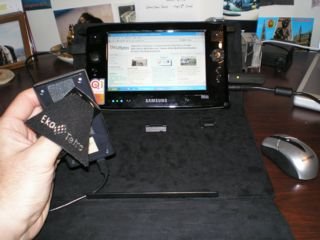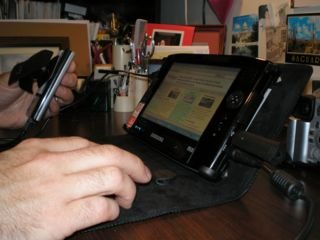The Samsung Q1 and EkaTetra EkaPad

The UMPC (ultra mobile personal computer) is a new platform most easily described as a half-tablet PC configuration, about the size of my old paper Filofax and Newton PDA (more below). I am evaluating the Samsung Q1 which is the only model I can currently find that is shipping from resellers (www.cdw.com). It runs Windows XP Tablet Edition that adds voice and handwriting recognition capability. Mouse input is replaced by a touch screen and stylus. It has been compared to the Newton MessagePad 2000 which it certainly reminds me of, however this is no solid state device. It packs a 40GB hard drive, 512MB RAM and a high-res, bright color screen. This of course is its achilles heel since the battery life is no longer than your typical laptop (2-3 hours intensive use). A far cry from the MP2000's 8-10h capability. For more in depth reviews, check out,
- The Samsung Q1 UMPC performs well on the road, http://www.geek.com/news/geeknews/2006Jun/lab20060615036900.htm
- Why will people want UMPCs?, http://www.mobileread.com/forums/showthread.php?threadid=7436 http://www.geek.com/news/geeknews/2006Aug/bpd20060829038315.htm
I have been beta testing the Q1 with the new Ekatetra (www.ekatetra.com) one-handed, USB keypad, called the EkaPad. This 12-key, handheld, chording keypad is an exciting development in the art and science of text and data entry that finally captures the needs of on-the-go text
entry in a device that is only slightly larger than a business card. It emulates both standard Mac or Windows full-size keyboards, and is therefore completely plug n' play on USB systems. The EkaPad can be used in either hand (no handedness in the design), and in any physical position, e.g., standing up, sitting down, lying on your back, etc. Obviously operating a chording keyboard is different to a QWERTY keyboard, but the EkaPad is easy to set up and learn using the variety of tools supplied and online support available. And you can practice as you go by placing a handy reference card called the "cheat sheet" on your computer's screen.
- EkaPad - your personal, single-handed keypad, http://www.ekatetra.com/information_news/pr060711-ekapadlaunch.html
- White Paper: About the USB EkaPad, http://www.ekatetra.com/information_news/pr060711-ekapadlaunch.html

Alternatively, the EkaPad can be attached anywhere using the EkaHand strap or a strip of DuoLock™. So I was actually able to mount the keypad to the back of the Q1, and then enter text while holding the Q1 in both hands. The only thing missing was a thumb joystick for my right hand (something to give the UMPC developers to think about!). The sky is the limit with this keyboard. I am already imagining be able to perform text-entry while walking/jogging though I doubt I will be able to Web browse with this screen since due to it's fine resolution/pitch. But a larger external screen mounted could make it as easy to read as news/magazine print.

So be honest, when was the last time you where able to open your laptop in a coach airplane seat, use a laptop while seated in the car, or curl up on the sofa with a good laptop? This is a really cool mobile computer & keyboard combination that allows you to comfortably enter text into your computer in more unconventional, relaxed and informal settings.
Summary
I have to agree that the battery life is a major downside of the Q1 since most ambulatory computer users need at least 8 hours to pull a shift or a day's work. But on the whole the UMPC is a step in the right direction, and the Ekapad is a great little mobile keypad.
No comments:
Post a Comment